Key takeaways
- Queer women culture is defined by authenticity, resilience, and diverse identities, creating a supportive community that transcends societal challenges.
- Meetup serves as an effective platform for fostering real-world connections, allowing individuals to build meaningful relationships in safe spaces.
- Successful engagement strategies include creating intentional events, maintaining ongoing dialogue with members, and embracing their feedback to shape the community.
- Overcoming challenges in queer spaces involves fostering openness, addressing microaggressions, and prioritizing inclusivity to cultivate a trusting environment.
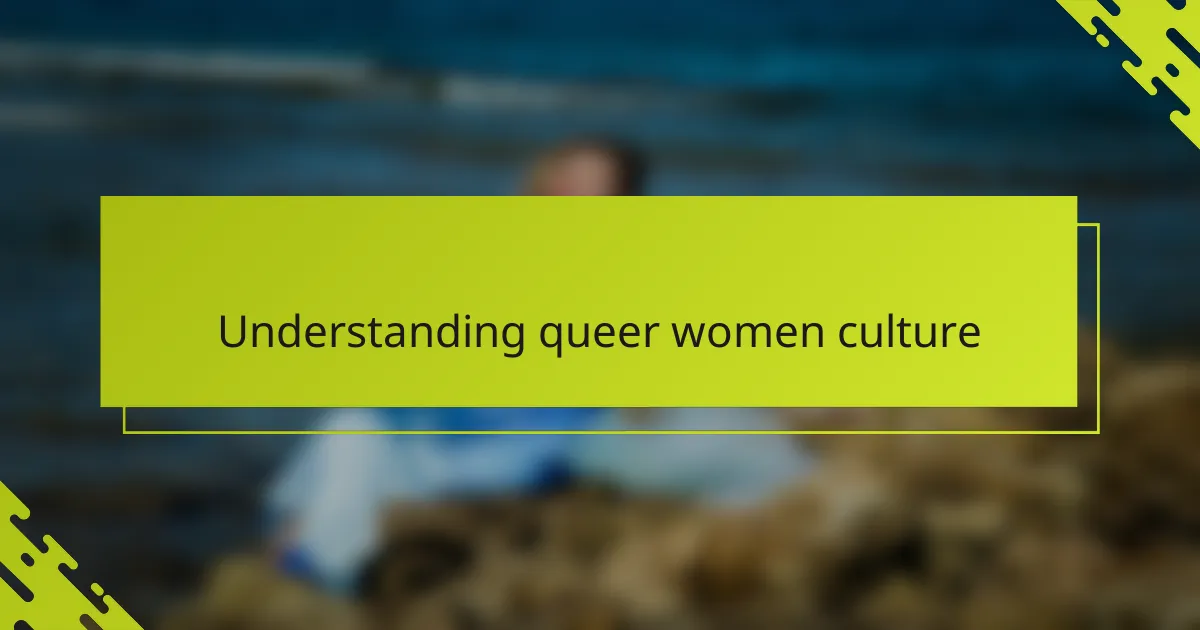
Understanding queer women culture
Queer women culture is beautifully diverse, yet it often feels like a hidden tapestry woven from countless unique stories. I’ve found that understanding this culture means recognizing the subtle nuances in how identity, community, and expression intersect for so many women. Have you ever noticed how something as simple as a shared look or phrase can hold layers of meaning that outsiders might miss?
From my experience, queer women culture thrives on authenticity and resilience. It’s about carving out spaces where vulnerability is met with support, and where joy can flourish despite societal challenges. I remember attending a local gathering where the atmosphere itself felt like a warm embrace—something I hadn’t anticipated but deeply needed.
What stands out the most to me is the fluidity within this culture; identities and experiences don’t fit into neat boxes here. This openness challenges us to rethink traditional ideas about gender and relationships, encouraging a more expansive understanding that’s both personal and political. Isn’t that complexity what makes the community so rich and inviting?
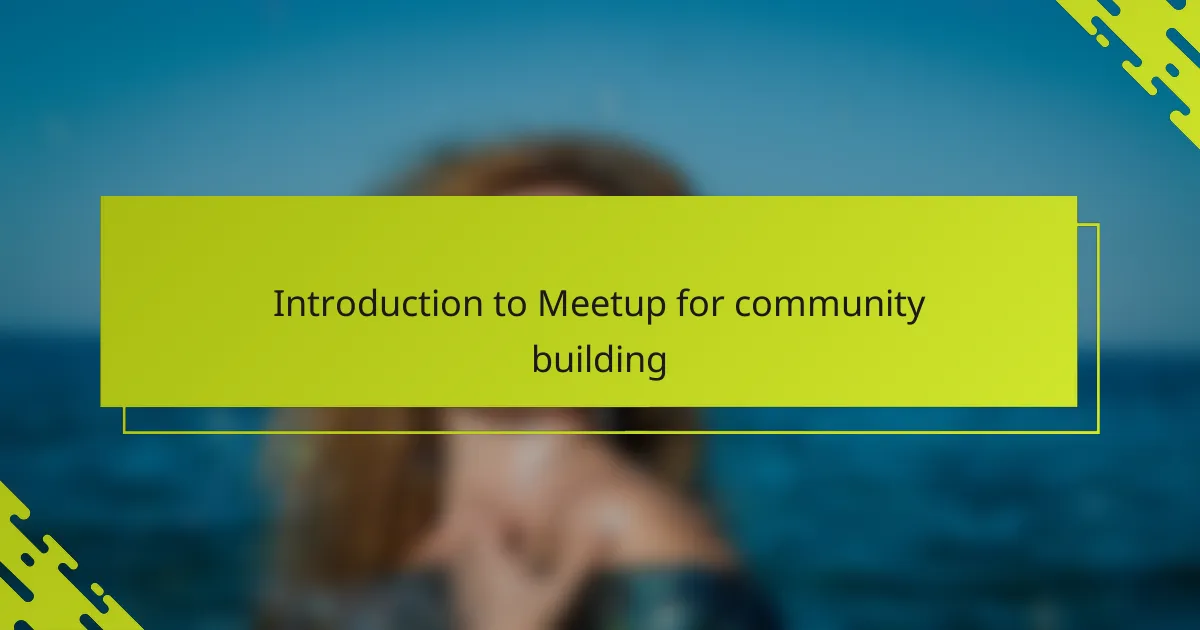
Introduction to Meetup for community building
Meetup has always struck me as more than just a platform—it’s really a catalyst for connection. When I first stumbled upon it, I was curious about how digital tools could spark real-world community, especially for queer women who often navigate spaces that don’t quite fit their needs. Have you ever wondered how a simple event listing could turn into a vibrant gathering of authentic voices and shared stories?
In my early attempts, I saw Meetup as a way to create not just meetings, but safe places where people could bring their whole selves without judgment. Setting up that first event felt daunting, but the moment people showed up, eager and hopeful, I realized this was the start of something meaningful. It’s amazing what can happen when we have the right platform to hold space for each other.
What makes Meetup so powerful, I think, is its simplicity paired with intentionality. You’re not just organizing an event; you’re building a foundation for ongoing relationships and collective support. Don’t you find that when community is genuinely fostered, it transforms from a gathering into a source of strength and belonging? For me, that’s the essence of building through Meetup.
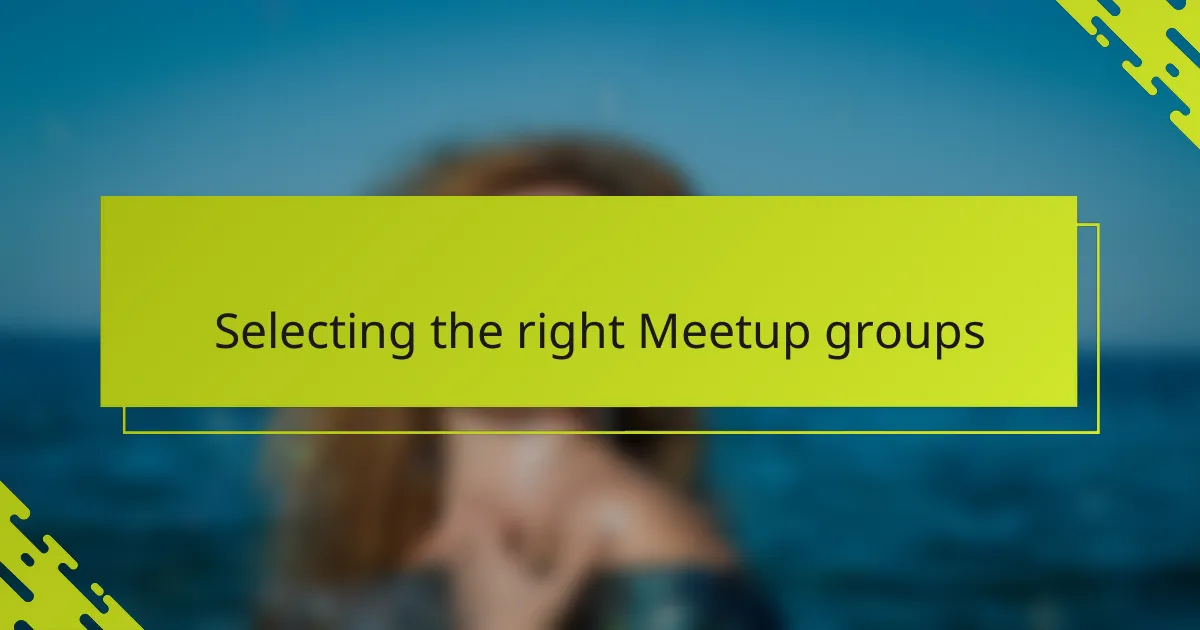
Selecting the right Meetup groups
Choosing the right Meetup groups felt like stepping into a carefully curated world where I could both learn and contribute. I quickly realized that not every group, even if labeled “queer women,” aligned with the authentic connections I was seeking. Have you ever joined a group expecting warmth but instead found it felt distant or overly broad?
What helped me was focusing on groups that clearly prioritized inclusivity and shared values around queer women’s experiences. I remember one group whose event descriptions were thoughtful and intentional, fostering discussions around identity and culture rather than just casual socializing. That sense of purpose made me feel instantly more comfortable and eager to participate.
I also found it valuable to test the vibe by attending different groups before fully committing. Did the organizers listen? Was the space respectful and open to diverse stories? Asking myself these questions helped me trust my instincts and gradually find a community where I truly belonged.

Strategies to engage and grow members
One strategy I leaned into was creating consistent, themed events that resonated deeply with members’ interests and experiences. For example, hosting monthly storytelling nights where queer women shared personal journeys sparked lively conversations and fostered a real sense of intimacy. Have you noticed how familiar rhythms and rituals in gatherings help people feel more anchored and eager to return?
Another approach that really made a difference was active engagement beyond the events themselves. I made a point to follow up with attendees, check in with new members, and encourage connections through online chats between meetups. This kind of ongoing dialogue showed people they were truly valued, not just names on a list. It’s amazing how these small gestures build trust and make a community feel alive and growing.
Lastly, embracing member input became a cornerstone in shaping the group’s evolution. I often asked, “What do you want to see next?” or “How can we make this space better for you?” Listening carefully and adapting based on feedback not only made members feel heard but also created a shared ownership of the community. Isn’t that collaborative spirit what turns a gathering into a thriving, supportive network?
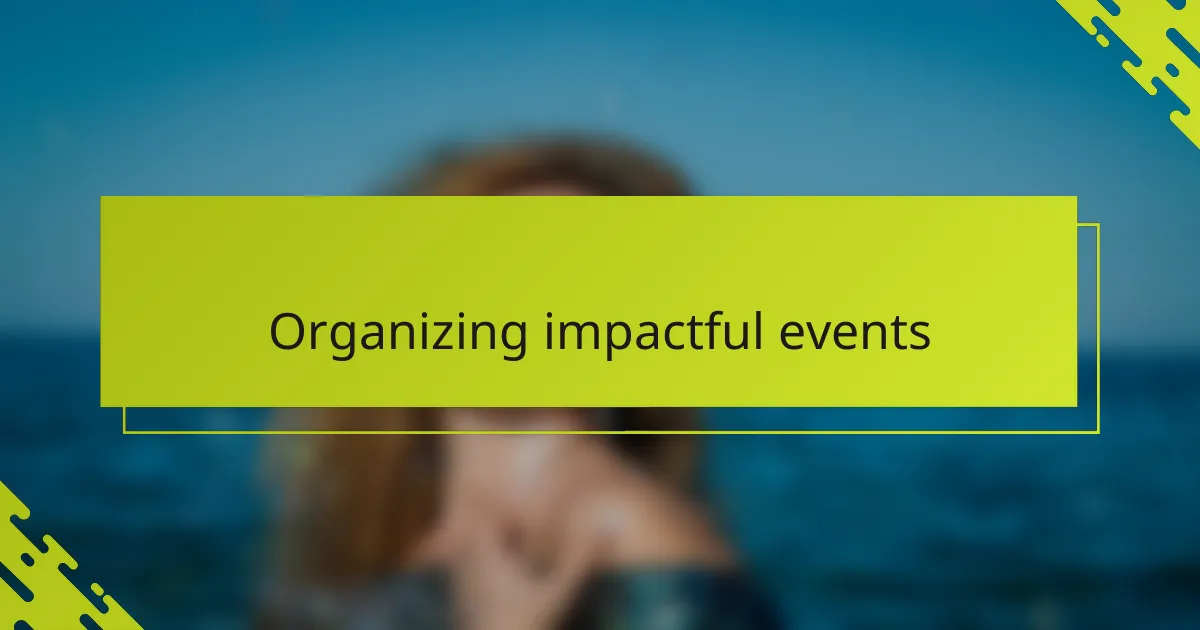
Organizing impactful events
When organizing impactful events, I quickly learned that intention matters more than scale. It’s not about packing a room but about creating moments where every person feels genuinely seen and heard. Have you ever noticed how an event’s energy shifts when attendees sense that the space is crafted with care and respect for their identities?
I found that thoughtful details—like choosing accessible venues, incorporating queer women artists, or offering various ways to participate—made all the difference. These small but deliberate choices signaled that the event wasn’t just another gathering, but a purposeful experience that honored our community’s diversity. That feeling of intentionality often turned first-time attendees into regulars who brought their own stories and ideas.
Sometimes, the most impactful events arose from embracing vulnerability myself. I remember sharing my own journey during a meetup once; it opened up a ripple of openness among attendees I hadn’t anticipated. What I realized then is that when organizers lead with authenticity, it invites others to do the same, turning an event into a collective space of trust and growth.
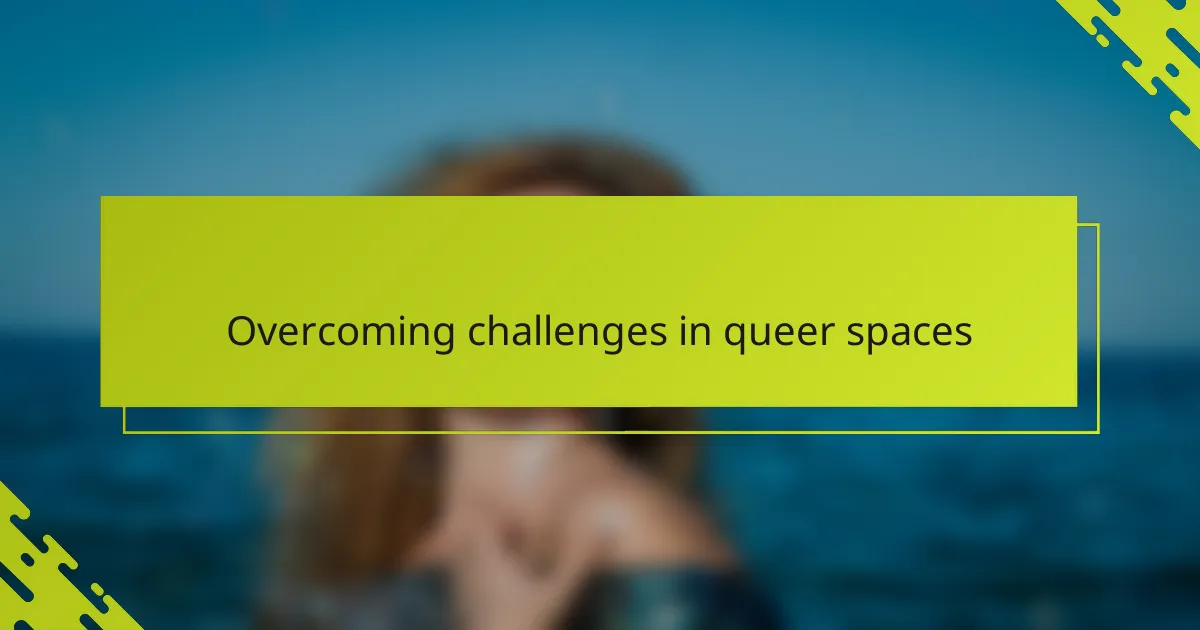
Overcoming challenges in queer spaces
Navigating queer spaces hasn’t always been smooth, especially when vulnerability meets hesitation. I’ve seen firsthand how past hurts or fear of misunderstanding can make people hold back. Have you ever felt that tension—wanting connection but hesitating because the space doesn’t yet feel fully safe? It’s a delicate balance that requires patience and a lot of genuine listening.
At times, I encountered microaggressions or assumptions that sapped the warmth from gatherings. Those moments were tough, but they pushed me to create clearer guidelines and foster open conversations about respect and boundaries. What surprised me most was how openly people responded when given that space—it reminded me that challenges can become catalysts for deeper trust.
Sometimes the biggest hurdle was overcoming the feeling of invisibility within broader queer conversations. Queer women’s experiences are often sidelined, and carving out dedicated spaces felt like an act of resistance. But each time I witnessed someone find a voice or a friend in these meetups, it affirmed that persistence in overcoming these barriers is worth every effort. Isn’t that what community is truly about—showing up despite challenges and making space for each other?
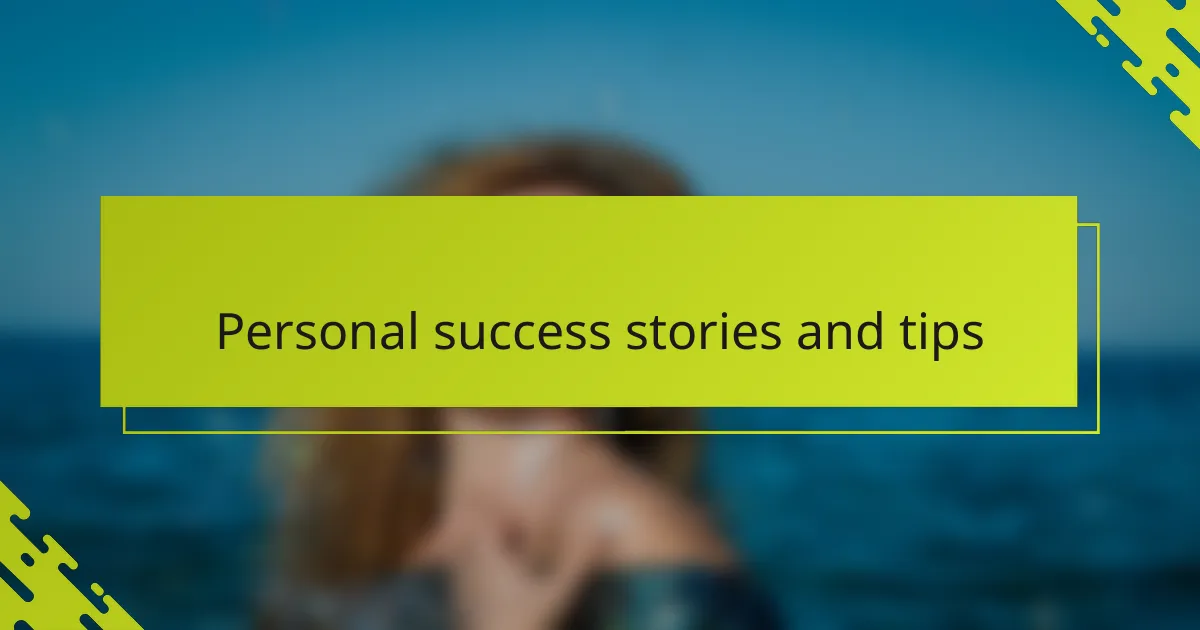
Personal success stories and tips
One of the most rewarding moments for me was when a shy attendee returned week after week, slowly opening up and eventually co-hosting an event. Have you ever watched someone find their confidence in a space you helped create? It’s deeply humbling and reminds me why perseverance matters in building community.
A tip I found invaluable is to prioritize listening over leading, especially in the early stages. When I shifted my focus to really hearing members’ stories and needs, the group’s energy transformed. Isn’t it interesting how simply creating room for others to speak can spark such connection?
Also, trust your instincts when choosing themes or activities. I once proposed a spontaneous art-sharing evening, unsure of the response, but it ended up becoming a cherished tradition. Taking small risks grounded in member interests often leads to the most memorable and meaningful moments.
